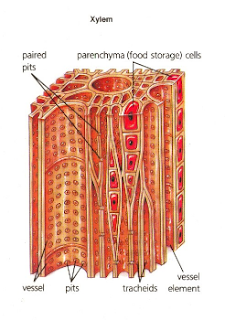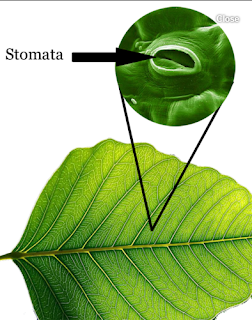Batrachospermum Occurrence:- (1) Batrachospermum is fresh water alga. (2) It is found in clear, cool, and running streams. (3) Deepwater plants are dark violet or reddish in color. But the shallow-water species are olive green. (4) The intensity of light changes the color of pigments. (5) The thallus is attached to the substratum. Vegetative structure (1) The thallus of an adult plant is soft, thick, filamentous. (2) It is freely branched and gelatinous. (3) The central axis is made up of a single row of large cells. Whorls of branches of limited growth are developed on this axis. (4) These branches are filamentous and dichotomously arranged. (5) The main axis is corticated. It consists of a row of elongated cylindrical cells....
Transpiration of Water and Food
Means of Transport
3 suggests that of transport in plants:
DiffusionFacilitated Diffusion
Transport
 |
| Transpiration |
Diffusion:-
- movement of molecules from high concentration to low concentration while not a semi-permeable membrane.
· Slow method
· No expenditure of energy
· Diffusion depends upon: Concentration gradient, porousness of the membrane, Temperature, Pressure and Size of the substance.
Faciilated Transport :-
· In facillated diffusion, the membrane proteins ar concerned. they supply a web site for hydrophilic molecules to have the membrane and no energy is needed.
· Proteins concerned within the method type channels which can invariably be opened or controlled. Facillated diffusion is incredibly specific
.
· Porins: -
Proteins that forms vast pores within the outer membranes of plastids, mitochondria, etc. they're completely different kinds;
· Aquaporins:-
Proteins that facilitate diffusion of water molecules
· Transport may be of three types:
o Symport
o Antiport
o Uniport –
independent movement of molecules
· once all proteins concerned ar saturated, it results in most transport.
Active transport:-
· needs special proteins that ar terribly specific and sensitive to inhibitors.
· needs energy to pump molecules against the concentration gradient.
· once all proteins concerned ar saturated, it results in most transport.
Water Potential (ψW) :-
· larger the concentration of water during a system, larger is its K.E. and larger is that the water potential.
· it's measured in Pascal (Pa).
· If 2 systems ar in touch, then there's movement of water from the answer with larger water potential to lower water potential.
· substance potential (ψs) substance is additional to the water
· Pressure Potential (ψp) pressure larger than gas pressure is applied to pure water or an answer
· Water potential of pure water is zero.
· substance potential is usually negative and water potential is usually positive.
· ψw = ψs + ψp
Osmosis :-
· Water diffuses from region of its higher concentration to its lower concentration through semi-permeable membrane.
· Diffusion of water across a semi-permeable membrane
· Direction and rate of diffusion depends upon pressure gradient and concentration gradient.
· pressure level − External pressure applied to forestall the diffusion of water It depends upon substance concentration.
· Numerically, pressure level is up to diffusion potential
· pressure level has positive sign. diffusion potential has negative sign.
Types of Solutions:-
· solution :-
o Concentration of external Solution is up to Concentration in protoplasm
o there's no web gain, thus No amendment in cell size.
· Hypotonic Solution
o Concentration in protoplasm is larger than the Concentration of external Solution
o therefore water enters into the cell well.
· Hypertonic Solution
o Concentration of external solutions is larger than the Concentration in protoplasm.
o thus water moves from cells to external Solution and Cells shrink.
Plasmolysis
o It happens once cell is placed in hypertonic Solution , as a result of water moves out from protoplasm and cavity. thus semipermeable membrane shrinks aloof from the semipermeable membrane.
o As water moves in, protoplasm builds up a pressure against the semipermeable membrane.
This pressure is termed state pressure and cells enlarge.
Imbibition :-
· Diffusion during which water is absorbed by solids, inflicting them to tremendously increase in volume.
· Imbibition is on the concentration gradient and depends upon affinity between adsorbent and liquid being adsorbable .
· samples of soil, swelling of picket door throughout season, swelling of raison once soaked in water.
Long Distance Transport of Water:-
It happens by 3 processes, Diffusion, Mass flow system and Translocation through conducting vascular tissues.
There ar 2 kinds of conducting tissues, namely;
Xylem:-
Transports water, salts, element and hormones.
From roots to the opposite elements and it's simplex.
Phloem:-
 |
| Structure of Phloem |
Transports organic and inorganic solutes.
It happens from the supply (leaves) to the sink (storage part) and it's multidirectional.
Absorption of Water by Plants :-
· Water is absorbed through roots by diffusion.
· Root hairs (slender, thin-walled extensions of root dermal cells) increase the expanse for absorption.
· Once absorbed by root hairs, water moves into deeper layers by two pathways − Apoplast Pathway or Symplast Pathway.
Apoplast Pathway: -
· Movement happens through the living thing areas or walls of the cells, while not getting into the protoplasm. Movement is quick. Most of the water flow in roots happens via apoplast, except at the casparian strip
Symplast pathway: -
· Water enters the cell through the semipermeable membrane and travels intracellularly through plasmodesmata.
Movement is slow. At the casparian strip region, water moves through the symplast.
· Most of the water enters through apoplast pathway, endodermis has casparian strips that ar manufactured from suberin, it's mothproof to water, therefore water enters the symplast.
There ar 2 forces that ar chargeable for transporting the water up during a plant; they're root pressure and transpiration pull.
Root Pressure :-
· Water molecules enter from soil to plant organ, then to animal tissue cells and eventually reach vascular tissue vessels.
· Positive pressure created within the vascular tissue once water transported on the concentration gradients into the system
· Guttation grass blades and leaves of nonwoody plants.
Transpiration pull :-
· Transpiration may be a method of loss of water within the kind of water vapours from the surface of leaves.
· Transpiration accounts for loss of ninety nine of water taken by the plant.
Loss is especially through stomata.
· Pull of water as a results of tension created by transpiration is that the major propulsion of water movement upwards during a plant.
· There ar 3 physical properties of water that have an effect on the ascent of vascular tissue sap because of transpiration pull.
o Cohesion o Adhesion o physical phenomenon larger extent than to water in evaporated part
Transpiration :-
· It happens manly through openings referred to as stomata.
Transpiration provides the transpirational pull that is chargeable for the upward movement of water in tall plants.
· Stomata:
o Open within the day and shut throughout the night
o conjointly contribute within the exchange of O2 and CO2
o gap and shutting of stomata is influenced by the wordiness of the guard cells.
Factors moving transpiration:
· External factors: Temperature, Light, humidness and Wind speed.
· Plant factors / Internal factors: range of stomata, distribution of stomata, water standing in plants.
Importance of Transpiration
· Creates transpirational pull for transport
· provides water for chemical process
· Transports minerals from soil to any or all elements of a plant
· Cools the surface of the leaves by evaporation.
· Keeps the cells turgid; thus, maintains their form Uptake of Mineral Nutrients
· Minerals ar absorbed from the soil by transport.
They cannot follow transport due to 2 factors;
o they're charged.
Hence, they can't cross the cell membranes.
o Concentration of minerals in soil is lesser than the concentration of minerals in roots.
Hence, concentration gradient isn't gift.
· sure proteins within the membranes of plant organ cells actively pump ions from soil to protoplasm of dermal cells.
Transport of Mineral Nutrients
· Unloading of mineral ions occur at fine vein endings of the leaves through diffusion.
· Some minerals are remobilised from previous senescing elements N, P K, S. Minerals forming structural elements (example Ca) aren't remobilised.
Phloem transports food from supply to sink, however this source-sink relationship is reversible relying upon the season.
Therefore, bast transport is bi- directional.
Mass flow Hypothesis:
· this can be the well accepted mechanism used for translocation of sugars from the supply to the sink.
· aldohexose ready at the supply is reborn into saccharose. saccharose is rapt to the companion cells, so to the living bast vascular tissue cells by transport.
This method of loading creates a hypertonic condition within the bast.
· Water within the adjacent vascular tissue moves into the bast by diffusion.
Osmotic pressure builds bast sap.
· As fluid mechanics pressure on the bast vascular tissue will increase, pressure flow begins and sap moves through the bast to the sink and hold on as advanced carbohydrates (starch).




Comments
Post a Comment
Thanks